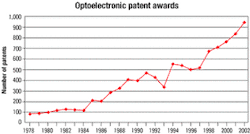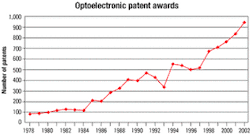Does the U.S. have a weakening will to create?
As the Figure illustrates, the sustained upward trend over 24 years in the number of OE patents issued by the USPTO confirms the broad interest in such technology. It also suggests that OE products are being redirected from highly specialized niche markets to "commodity" markets where automated high-volume production promises to force down even further the prices for OE components and integrated products. The upward trend is something of a surprise because the telecommunications recession should have affected OE research by now. On the other hand, the rising trend may derive more from Asian and European research efforts rather than American.
Table 1 lists in descending order the number of patents issued to the assignee (usually a corporation but occasionally a government) and "days to approval," which is the number of days that elapsed between the date of the patent filing and date of issue. Although Corning and IBM had several patents approved, for the first time an Asian-based company tops the list. In the past, Lucent Technologies was the perennial OE leader, but that title passes to Taiwan Semiconductor Manufacturing. The presence in the list of two other Taiwan-based organizations, the Industrial Technology Institute and Hon Hai Precision, as well as Japan-based Sumitomo Electric, confirms the growing strength of Asian-based OE producers.
Judging from the "days to approval" data, the case could be made that these organizations submit better patent filings with the USPTO than the other assignees. Asian-based assignees acquire their intellectual property in less than 650 days, substantially lower than the average wait time of 874 days for OE patents issued in 2002.
That average wait time was 20 days longer than the 854 days averaged in 2001. The growing wait time reflects problems at the USPTO. Patent fees are diverted from the agency to other parts of the federal government, reducing the USPTO's budget. In June 2001, Ronald Myrick, president of the Intellectual Property Owners Association, which represents a significant number of companies and industry associations, told the House Judiciary Subcommittee, "More resources also are needed to improve quality of patent examination....The prospect that the [wait] time...will rise to 38.6 months by 2006 is unacceptable to American companies....[T]he PTO is starved for funds."
The Bush administration has yet to remedy the USPTO's plight, continuing to withhold nearly $200 million annually from an agency that processes hundreds of thousands of patents and applications each year while maintaining a database approaching 10 million records.
Table 2 shows the descriptive detail that composes an OE patent. The term is a composite because the USPTO classifies a patent according to one or more of approximately 450 major patent classes and subclasses, none of which is "optoelectronic." Any assignee dealing with optoelectronic issues has a 50% chance of having expertise in one of the following research fields: optical waveguides, active solid-state devices, semiconductor manufacturing, optic systems, radiant energy, optic measuring and testing, stock material, and coherent light generators.
For example, of the 951 OE patents issued in 2002, 164 were for optical waveguides, but some of those same patents may also have been for coating processes or image analysis. Thus the "total" of 1,467 is larger than the 951—another way of saying that each patent deals with "1.54" fields of research. Also, there is a better than 50% chance that an OE patent will contain the words "fiber," "fiber optic," or other key words. Taken as a whole, these details compose the OE patent and appear to be stable identifiers, because the distribution in Table 2 is consistent with distributions found for the years 2000 and 2001.
The OE patent data is a base to examine a major issue that bedevils the fiber-optic industry and continues to roil in Congress, the Supreme Court, and the Federal Communications Commission. Why is there so little investment and so little effort to push fiber optics into the local loop? According to a recent article in Legal Times by Washington, DC, attorney James H. Johnston, "five years after Congress said it wanted rapid deployment of broadband services that would permit users to originate and receive high-quality video, only 3,523 such lines were in service," despite Section 706 of the Telecommunications Act of 1996, which specifically calls for such deployment.
Incumbent telephone companies have long asserted that the Telecom Act suppresses their drive to invent, research, and commercialize "new" technology; thus, there is little reason for them to pursue fiber deployment in the local loop. In May 2002, Supreme Court Justice Stephen Breyer agreed with that position, writing an opinion dissenting from a majority that had concluded incumbent telephone companies must continue to share their facilities with competitors. Breyer wrote: "[W]hat incentive [is there for]...incumbents either to innovate or to invest in a new 'element'? The rules seem to say that the incumbent will share with competitors the cost-reducing benefits of a successful innovation, while leaving the incumbent to bear the costs of most unsuccessful investments on its own."
One way to prove the worth of Breyer's theory is to examine the incumbents' patents through time to see if there is a discernible pattern and if it supports his conclusion. Tables 3, 4, and 5 summarize the results for 1992 through 2002 regarding nearly 1,800 patents issued to incumbents under their various names and research organizations, including but not limited to Ameritech, Bell Atlantic, Bell Communications Research, GTE Laboratories, Qwest Communications, SBC Communications, Telcordia Technologies, US West, and Verizon. In cases where a patent was issued jointly, the patent was considered an incumbent patent if the first-named assignee was an incumbent. The Tables use the term "RBOC," the old term for regional Bell operating company, for the sake of brevity and space limitations.
Table 3 provides a comparison of the OE patent-class distribution in 2002 against the RBOC patent distribution. For example, column 5 lists the number 385 as the patent class number for optical waveguides; column 1 shows in 1992 the RBOCs received 14 optical-waveguide patents; column 2 shows those patents as 5% of the total patents issued to RBOCs in 1992. The remarkable fact is that the RBOCs' 1992 patents embodied substantial research in the very same fields central to optoelectronics. Of the 21 patent classes composing two-thirds the OE patents in 2002, 20 classes are common to the RBOCs' 1992 patents and compose 36% of the research fields embodied in the 1992 patents. Over a decade ago, the incumbents had a research interest in pushing fiber in the local loop.
But that was the tail-end of this correlation; by 2002, there is almost no similarity between the RBOCs' research and OE patents, as shown by the data in columns 3 and 4. Table 4 lists the year-by-year decline in similarity. The RBOCs' research path changed dramatically after 1992, moving quickly away from research that would aid fiber-optic penetration of the local loop.
Table 5 shows where the RBOCs went. It is a matrix in which each entry is a display of "patent class number/number of patents/percentage of total patents." In 2002, for instance, 83 RBOC patents were assigned to research field 379, "Telephonic Communications," which composed 28% of the research fields embodied in the RBOC patents, a contrast with 1992, when only 13 patents were assigned in that research field. There are more than 500 subclasses in field 379, but only three relate to fiber systems. They are subclass 56.2, "a fiber-optic link within a telephone network"; 259, "deflected electron-beam switching device or mechanical or optical-switching control"; and 379, "optical link between line and switching system." These subclasses appear in less than 10 telephonic patents for the entire period of 1992-2002. The other leading research field, 370, "Multiplex Communications," has over 300 subclasses but only two relate to fiber systems: 907, "Synchronous Optical Networks (SONET)," and 906, "Fiber Data Distribution Interface (FDDI)." These two subclasses appear in only five RBOC multiplexing patents. The remaining major fields are 455, "Telecommunications," 705, "Data Processing Financial," 707, "Data Processing Database Data Structures," and 709, "Electrical Computers Digital Processing."
The trends speak for themselves. Long ago, the incumbents turned to traditional research that would shore up existing markets and in-place technology. Therefore, they have no position in the OE market and have no stream of royalties to anticipate when fiber moves deeper in the loop. It is true that the incumbents' research efforts have not been aimed at developing the "new" telecom element, as Justice Breyer claims. But those research efforts were set in a mold well before the Telecom Act became law or was being negotiated. Also, the rapid increase of patents in the incumbents' traditional fields of expertise contradicts claims that their research efforts are suppressed by the Act.
The large U.S. telecom institutions turned away from OE research at a time when it was gathering speed, as it still is throughout the world, and today American firms no longer lead OE research and development.
Stephen N. Brown writes on public policy in telecommunications. He can be reached at 615-399-1239 or [email protected].

